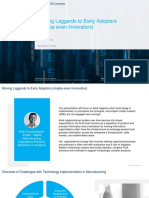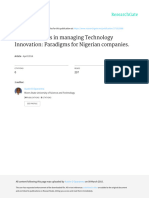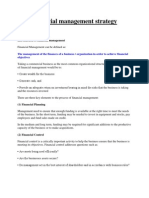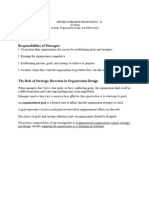Solving Real Problems with Technology
The shiniest tool in the shed won't build the house by itself
The allure of new, cool tech solutions often overshadows their practical utility. Both sides—
the innovators who create and sell these technologies and the customers who eagerly adopt
them—share responsibility for a growing trend of technology implementations that, frankly,
don't solve real problems. This phenomenon can be best described as the Tech Paradox,
where the excitement of new technology blinds organizations to the necessity of a well-
thought-out strategy that ensures these tools are truly beneficial.
Drivers of the ‘Tech Paradox’
Shiny New Object Syndrome:
The irresistible pull towards the ‘new’ and ‘novel’ often comes at the expense of
sustained objectives and an overarching strategic vision. Businesses are enticed by the
latest technologies, viewing them as quick fixes to complex problems or as symbols
of modernization. The shiny new object promises instant gratification, and in the rush
to adopt it, companies may overlook whether it fits within their long-term goals. The
result? Expensive tech solutions that gather dust because they weren’t truly needed or
fully understood.
Fear of Missing Out (FOMO):
The anxiety that failing to adopt new technologies or trends could result in missed
opportunities for growth or competitive advantage is a powerful driver behind many
hasty tech investments. Companies often fear being left behind in the fast-paced
digital landscape, leading them to jump on the bandwagon without fully assessing
whether the new technology aligns with their needs or capabilities. This FOMO-
driven adoption leads to technology implementations that may not solve the core
challenges the business faces, but instead add layers of complexity without delivering
real value.
According to a study by Mari, Mandelli, and Algesheimer (2024), this fear can
directly impact decision-making, often leading to the prioritization of popular but
immature technologies that may not align with a company’s strategic needs. The
research highlights that FOMO is experienced at multiple levels within an
organization—firm, team, and individual employee—each with its own specific
targets and responses. For instance, decision-makers might feel pressured to adopt a
new technology simply because their competitors are doing so, leading to inflated
expectations and potentially poor outcomes. The study emphasizes that while FOMO
doesn’t automatically result in bad decisions, it can skew the rational decision-making
process by making executives more susceptible to biases and unrealistic expectations.
This is why it’s crucial for businesses to be aware of FOMO’s influence and ensure
that their tech adoption strategies are grounded in thorough evaluation rather than just
the fear of being left behind.
The reality check
Despite the excitement and the investments, the outcomes often fail to meet expectations. The
statistics paint a sobering picture of this reality:
61% of CIOs admit FOMO (Fear of Missing Out) drives their investments in
emerging technologies:
According to Ardoq, the anxiety of being left behind pushes many companies to
invest prematurely, often without a fully developed strategy.
66% of CIOs fear their competitors will "eat them for lunch" if they don’t move
quickly on AI:
� According to Ardoq, the pressure to adopt AI swiftly often leads to hasty decisions
without fully understanding the long-term implications.
70% of Digital Transformation initiatives don’t meet goals: Boston Consulting
Group reports that the majority of digital transformation efforts fall short of their
goals, largely due to inadequate planning, lack of strategic alignment, and failure to
engage stakeholders throughout the process.
70% of manufacturers worldwide are stuck in pilot purgatory: McKinsey
highlights that many manufacturers find themselves unable to move beyond the pilot
stage of digital initiatives, unable to scale solutions across the organization, resulting
in wasted resources and stalled progress.
58% of IoT projects are considered unsuccessful: Beecham Research reveals that
over half of IoT projects are deemed failures, often due to a lack of clear objectives,
poor execution, and challenges in demonstrating tangible benefits.
61% of manufacturers don’t have specific metrics to measure the effectiveness or
impact of AI deployments: The Manufacturing Leadership Council underscores the
importance of establishing metrics to gauge success, yet the majority of manufacturers
lack these critical tools, leading to unclear outcomes and unfulfilled promises.
Advice for the tech-curious companies
Given the allure and the pitfalls of technology adoption, companies must approach new tech
investments with a clear, strategic mindset. Here’s how to avoid the Tech Paradox:
1. Assess, Don’t Assume:
Before you swipe right on that sexy new software, make sure it's a match for your
actual needs. Consider whether the technology will integrate seamlessly with your
existing systems, whether it addresses a specific challenge, and whether it has the
potential to drive measurable improvements. Assumptions can lead to costly mistakes;
assessments grounded in data and aligned with business goals will guide you toward
more informed decisions.
2. Align, Then Act:
Your tech should fit your business plan like a glove, not like that itchy sweater from
your aunt. This means not just looking at the immediate benefits but also considering
the long-term implications. Will this technology support your company’s growth
objectives? Does it fit within your broader digital transformation strategy? Alignment
with strategic goals ensures that technology investments are purposeful and impactful,
rather than reactive or trend-driven.
3. Measure to Manage:
If you can't measure It, you can't manage It (or brag about it). Develop clear metrics
or KPIs to track the success and relevance of your technology investments. Without
measurable outcomes, it’s impossible to know whether a technology is delivering the
value promised. By setting clear benchmarks for success, you can manage your
technology portfolio more effectively, making adjustments as needed to ensure that
each investment continues to support your overarching strategy.
In the end, it's not about having the fanciest drill in the toolbox – it's about knowing how to
use the tools you've got to build something awesome. So, let's get smart about our smart tech,
shall we? After all, even Einstein didn't need a supercomputer to figure out E=mc².
Sometimes, a good old pencil and a bit of common sense are all you need to change the world
– or at least stop your business from buying another digital paperweight.
References:
� University of Zurich - Mari, Alex, Mandelli, Andreina, and Algesheimer, René - Fear
of Missing Out (FOMO) on Emerging Technology: Biased and Unbiased Adoption
Decision Making, 2024:
https://www.researchgate.net/publication/378397875_Fear_of_Missing_Out_FOMO_
on_Emerging_Technology_Biased_and_Unbiased_Adoption_Decision_Making
Ardop - Emerging Technology Adoption 2024: Navigating AI Risks, Rewards, and
ROI: Interactive CIO Report
Boston Consulting Group - Companies Can Flip the Odds of Success in Digital
Transformation from 30% to 80%, 2020: https://www.bcg.com/press/29october2020-
companies-can-flip-the-odds-of-success-in-digital-transformations-from-30-to-80
McKinsey & Company - Preparing for the next normal via digital manufacturing’s
scaling potential, 2020: https://www.mckinsey.com/capabilities/operations/our-
insights/preparing-for-the-next-normal-via-digital-manufacturings-scaling-potential
IoT Now - Why IoT projects fail, 2022 (Beecham Research Reference):
https://www.iot-now.com/2022/08/05/122841-why-iot-projects-fail/
Manufacturing Leadership Council - The Future of Industrial AI in Manufacturing,
2023: https://bit.ly/IndustrialAI2023






















































































